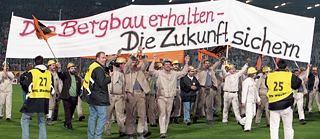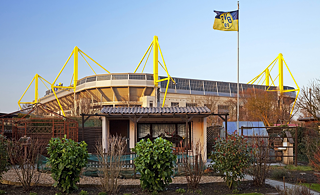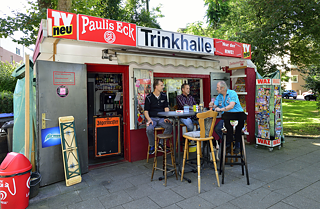Football in the Ruhr
In the Land of 1,000 Derbies

Matches will also be played at two stadiums in the Ruhr region during the 2024 European Football Championship. It’s not really surprising – this area in the far west of Germany is considered the nucleus of German football, especially away from the bright lights of the modern arenas.
By Hendrik Nolde
For many people in the Ruhr, football is a central component of their lives rather than some incidental pastime. Most children are predestined from birth to support the same team as their parents. Whether Borussia Dortmund, Schalke 04, VfL Bochum, Rot-Weiss Essen or MSV Duisburg: it’s no easy choice, as this region nestled between the Rhine and Ruhr rivers is awash with football clubs – some being amongst the biggest and most important in all of Europe. Then there are those illustrious names from the past that these days battle for victory in the lower leagues, such as Rot-Weiß Oberhausen or SG Wattenscheid 09. Neighbourhood duels are the order of the day – so it’s not for nothing that this region is known as the “land of 1,000 derbies”. Here, however, football is celebrated above all outside the major arenas of the Bundesliga teams. Every weekend, thousands of amateur players pit their strengths against each other on countless cinder pitches, and there’s rarely any hotter topic for regulars enjoying a beer at their local. Franz Beckenbauer was spot-on when he once said: “The Ruhr is the beating heart of football”.
Football in this metropolitan region in the far west of Germany is not least a social phenomenon. Closely intertwined with the history of mining in the region, football initially served as a welcome counterbalance to the tough work down the pit. When heavy industry declined, the success achieved by local football clubs offered a glimmer of hope in a region that felt stripped of its livelihood following the mine closures. The myth of the workers‘ clubs that enshrine the values of the pitmen persists and is deliberately exploited by the big clubs to cultivate a particular image – despite the millions paid in salaries and efforts to tap into new markets worldwide.
The soul of Ruhr football often only becomes apparent at second glance, however, as indeed does the charm of this region, which can initially appear somewhat bleak and grey. The concrete jungle conceals a gruff warm-heartedness, a vibrant cultural scene and a diverse urban society of a density that is probably unique in Germany. Football serves as a unifying element, it is the glue that holds society together. Regardless of team colours, this game that was once played by the ordinary working man has evolved to become a core element of regional identity and its cultural significance is being taken increasingly seriously – most recently in the shape of the special exhibition “Myth and Modernity. Football in the Ruhr Area” at the Ruhr Museum in Essen.



